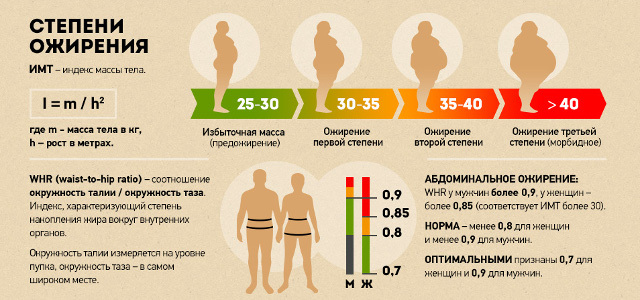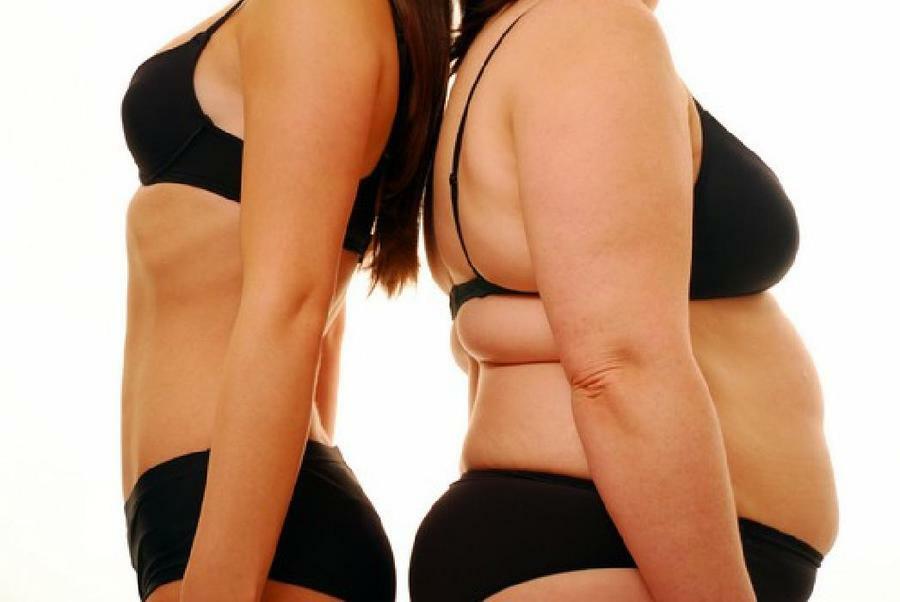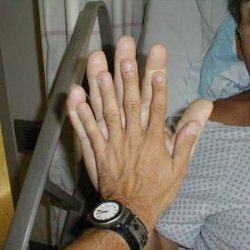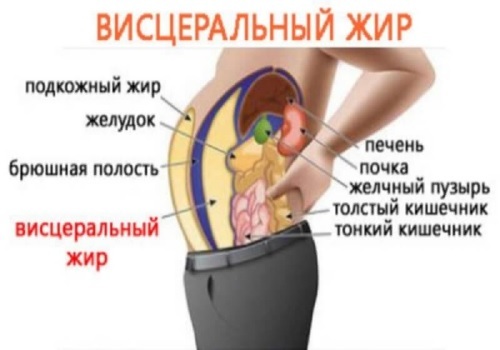Obesity and treatment of pathology

Obesity is the excess fatty deposits.This disease, which manifests an increase in body weight by 20% and more from the average.This condition is fraught with not only psychological discomfort for the patient, but also a multitude of complications from the internal organs and systems.In the modern world, obesity is compared with the global epidemic, because the disease can affect people of all ages.According to statistics, approximately 30% of the population of our country suffer from some degree of obesity.
Treatment of the ailment in question should be carried out in a comprehensive manner and include such basic components as regular physical activity, diet compliance, the use of medications and correction of the psychoemotional state and lifestyle in general.
Contents: Fat functions Obesity causes Obesity types and levels Obesity symptoms Obesity diagnosis Obesity treatment Adiposity nutrition Obesity preventionAdipose tissue functions
Few people know, but in the human body there are two types of adipose tissue: brown and white.Brown color of the first variety provides a lot of mitochondria present in the cell.It is this tissue that warms the person, especially at times when his movements are limited.In its pure form, it is localized in the thyroid gland and near the kidneys.In a mixed form - in the region of the chest and shoulder area, between the shoulder blades.A significant accumulation of fat is usually associated with the development of white adipose tissue, cells of which( adipocytes) are more like a large fatty vial that displaced the nucleus somewhere on the periphery.Most often, fat deposits form in the subcutaneous layer and in the abdomen.The thickness of fat on the stomach in some people can reach 20 or more centimeters.In addition to everything inside the peritoneum there is a special organ - an epiploon, capable of accumulating a significant amount of fat.There is also adipose tissue in the retroperitoneal space - around the pancreas, the aorta, the kidneys.
The main functions of adipose tissue include:
- Formation of the energy reserve.At the splitting of fat, 2 times more energy is released than with the splitting of carbohydrates, therefore fatty tissue actively participates in the vital activity of our organism, being a large energy depot.
- Participation in water exchange and passive neutralization of harmful substances.Splitting of fat is accompanied by the release of a large amount of water, much needed for physical exertion, excessive sweating and fasting.To all, fat tissue is able to deposit various toxins and degradation products, thus preventing poisoning of the body.
- Mechanical protection.Often, the fatty tissue serves as a kind of pillow that significantly reduces the consequences of injuries.Moreover, the fat-wrapped organs are better kept in place.
- Accumulation of vitamins A, D, E
- Endocrine function.It is in fat cells that many active substances are synthesized, including sex hormones.
I'd like to talk about the endocrine function separately.Most of all, the synthesis of such hormones as leptin and estrogens has now been studied.
Leptin - this substance was first isolated in 1994.At first, it was perceived as a certain substance responsible for a feeling of satiety, so they started to use it as a medicine for weight loss.However, subsequent studies have shown that this hormone regulates the duration of meal intervals.Those.Lowering the level of leptin leads to frequent feelings of hunger, but its use as a means to lose weight is unproductive, becauseIn the blood of full people it and so with an excess of
Estrogen .The fatty tissue contains the enzyme aromatase P450, capable of cleaving testosterone.Fat cells snatch this male sex hormone from the blood and convert it into female sex hormones - estrogens.Moreover, the older a person is and the more fat he has, the faster these processes occur.
For example, in healthy female representatives from 10 to 60% of sex hormones is produced by fat cells, as is their accumulation here.From body weight and fat volume in adolescent girls, changes in the pubertal period and the onset of the first menstrual period directly depend.During menopause in women, adipose tissue remains the main source of steroid hormones, which means that the nature of the course of the menopause is determined by its activity.
And it is these processes that explain the decrease in potency, the ability to fertilize and the presence of almost a woman's breast in men with a large "beer belly."
In addition to leptin and estrogens, fat tissue secretes resistin, adiponectin, tumor necrosis factor α, a number of extracellular proteins and enzymes.
Whatever the ode to this fatty tissue, it is necessary to remember that everything is good in moderation.And obesity is a disease that carries a number of menacing complications to a person.
Causes of obesity
 Obesity often becomes a direct consequence of a disparity between the energy expended and the energy that enters the body.That is, a person receives calories with an overabundance, which are not consumed, but are converted to fat.Because of this, the body weight increases, which leads to disruption of the internal organs and systems.Of all cases of obesity, approximately 90% is associated with overeating, yet a small percentage is given to disturbances in metabolic processes in the body.
Obesity often becomes a direct consequence of a disparity between the energy expended and the energy that enters the body.That is, a person receives calories with an overabundance, which are not consumed, but are converted to fat.Because of this, the body weight increases, which leads to disruption of the internal organs and systems.Of all cases of obesity, approximately 90% is associated with overeating, yet a small percentage is given to disturbances in metabolic processes in the body.
In case of abnormalities in the hypothalamus and pituitary gland, eating disorders develop.In obese patients, a decrease in the secretion of growth hormone, which performs lipolytic function( splitting of fats), there is hyperinsulinemia, disorders of the metabolism of thyroid hormones.
The very process of accumulation and consumption of fat deposits depends on several factors:
- the ratio of incoming and outgoing energy;
- the number of nutrients supplied with food;
- the relationship between the synthesis and decomposition of fat cells;
- genetics.
There are quite a few predisposing factors to obesity:
- lack of regular physical activity;
- hereditary predisposition;
- errors in nutrition, when the diet is dominated by carbohydrates, fats, salts, sugar;
- endocrine diseases, in particular, thyroid dysfunction;
- Mental disorders;
- bad habits;
- some physiological conditions( pregnancy, the period of breastfeeding, menopause);
- uncontrolled intake of hormone-containing and psychotropic drugs.So, obesity is a pathology that occurs in males and females of all age groups;Overweight is possible in childhood.To avoid complications and reduce the quality of life, the disease requires competent treatment under the supervision of a competent specialist.In modern medical practice, the problem of obesity is mainly practiced by endocrinologists.
Types and degrees of obesity
Recommended to read:The classification of obesity for the localization of fat deposits includes:
- femur-buttock type - inherent in the female part of mankind.Fat deposits form in the buttocks and thighs;
- abdominal type - fat is deposited mainly on the abdomen.Most often it develops in males;
- combined type - the fat is distributed evenly over the trunk.
Obesity can gradually progress, or remain in a stable stage.If we consider the mechanism of development of pathology, it is primary, secondary and endocrine. Primary obesity develops under the influence of the alimentary or exogenous factor .Secondary obesity often becomes a consequence of hereditary diseases, as well as some cerebral disorders.This type of described disease is also called symptomatic.The endocrine type is caused by the dysfunction of the glands of internal secretion.Hypodynamic disorders are noted in all forms of the disease.
The degree of obesity is determined by the body mass index, determined by the formula BMI = weight in kg / height in m sq:
- with the first degree of BMI is from 25 to 30, while getting rid of excess kilos is quite simple with the help of physical education and diet therapy;
- the second degree is characterized by a BMI of 30-35, when the risk of complications from the heart and vessels, as well as other organs, is already increasing.The peculiarity of the pathology at this stage is the rapid return of kilograms, which could be reset during treatment;
- BMI with obesity of the third degree is 35-40, in patients there is a pronounced restriction of mobility, dyspnea, bouts of overeating.The disease at this stage is difficult to treat, with the correction of nutrition and lifestyle is usually not enough, you need a special psychotherapeutic, medical or surgical treatment;
- 4 the degree of obesity is already a deadly condition in which BMI exceeds 40. In patients other than motor function disorders, there is constant shortness of breath, signs of respiratory and cardiac insufficiency.

Symptoms of obesity
The main sign of obesity is overweight.In patients, fat deposits can be present in the area of the shoulders and arms, back, abdomen, sides, buttocks and thighs.With all this, the muscles are not sufficiently developed.For patients with this disease, typical pathological conditions are inguinal and umbilical hernias.
At the first degree of the disease, any severe symptoms are most often absent.Some patients have increased sweating, drowsiness, swelling, constipation, pain in the spine and joints.In the later stages, already pronounced symptoms of disruption of the respiratory system, heart and blood vessels, gastrointestinal tract.In women, often against the background of excess weight, there are irregularities in the menstrual cycle, up to the complete absence of menstruation.It is also possible to violate the reproductive function, decrease the potency in men.
Depending on the type of illness patients may be disturbed by severe hunger at night, various endocrine disorders, sleep disorders.The complications of the disease include hypertension, chronic pulmonary heart and respiratory failure, pancreatitis, cholecystitis, arthrosis of the joints of the lower limbs, impaired function of the spinal column.Due to excessive sweating, skin, acne, striae, etc. often develop.In this case, the risk of developing diabetes mellitus, stroke and myocardial infarction is many times increased.
Important ! It is the pathological conditions developing against obesity that can lead to sudden death.
In addition, overweight is always a serious psychological problem.Discontent with one's own body leads to a low self-esteem, severe depression, and neuroses.
Diagnosis of obesity
 A survey of people with signs of obesity includes an analysis of anamnesis, hereditary predisposition, duration of the course of the disease, lifestyle and nutrition.The body mass index and fat distribution pattern are determined from the measurements of the thigh and waist circumference to the ratio of these two indices.
A survey of people with signs of obesity includes an analysis of anamnesis, hereditary predisposition, duration of the course of the disease, lifestyle and nutrition.The body mass index and fat distribution pattern are determined from the measurements of the thigh and waist circumference to the ratio of these two indices.If it is necessary to more accurately detect the volume and location of fat, ultrasound, X-ray densitometry and other studies may be prescribed.It is also possible to consult a psychotherapist, a nutritionist, a specialist of exercise therapy.
Definition of pathological changes in obesity includes:
- measurement of blood pressure;
- test for glucose tolerance;
- laboratory test to determine the level of cholesterol, triglycerides and lipoproteins;
- biochemical blood test.
Treatment of obesity

Complex treatment of obesity is not just a pronounced cosmetic effect, but also an improvement in the health and quality of life in general.At the beginning of therapy, patients are assigned a special diet in combination with physical activity.The need for such a combination is due to the fact that a hypocaloric diet reduces the basic metabolism and conservation of energy.Reducing the caloric intake of food consumed is due to the restriction in the diet of fats and carbohydrates with the predominance of protein foods and fiber.If a patient with a severe stage of obesity is treated in a hospital, he may be prescribed a short-term medical starvation.
As for exercise, they should be gradually increased.So, usually begin with the usual walk, with the number of steps per day should be at least ten thousand.The basic complex of physical exercises is selected by a qualified instructor of exercise therapy taking into account existing contraindications.Typically, the complex exercises include kardiagruzki( swimming, running, riding a bicycle, etc.) and power loads.The recommended duration and frequency of classes - 3-5 times a week for 30-40 minutes.
In the process of treating obesity, it is extremely important to lead a healthy lifestyle, as well as to cure associated complications.Over time, this mode of life will become a habit, and if this happens.The probability of returning the weighed kilograms is very low.
Please note! Those people who, after successful weight loss, return to unhealthy diet and a hypodynamic lifestyle, obesity often returns again and very quickly.
If necessary, the doctor may prescribe medication.Preparations for fighting excess weight are selected strictly individually, but it is worth remembering that they do not differ prolonged effect.Their reception is also recommended to combine with diet and exercise.The reason for prescribing drugs can be the absence of effect from dieting for three months or more, as well as a BMI of more than 30.
Drug therapy can be performed with drugs from the group of amphetamines, whose action is based on blunting of hunger and anorectic effect.However, such drugs also have side effects: sleep disturbances, allergic reactions, nausea, etc. Sometimes a good effect gives the reception of fat-mobilizing drugs and antidepressants.
For the correction of psychoemotional status, psychotherapy is recommended.Also in the fight against obesity, hypnotherapy is used widely enough to change the stereotypes of eating behavior and lifestyle in general.
In severe cases, surgical intervention will help get rid of obesity.Bariatric surgery is indicated with a BMI more than 40. Among its methods include such operations as gastric banding, vertical gastroplasty, gastroshunting.For cosmetic purposes, liposuction is possible - local fat removal.
Recommended reading:Nutrition for obesity

As in most cases obesity leads to banal overeating, it is the correction of eating behavior that is considered the most effective method of combating obesity.The diet involves limiting the energy value of the daily diet with the predominance of unsaturated fatty acids, protein, mineral salts and vitamins in the food intake.
People who are obese are recommended to eat five to six times a day in small portions.Dishes are best cooked steamed or boiled, limited use of salt and spices.It is desirable to significantly limit the consumption of bread, flour products, sugar, potatoes.If you can not do without bread, there is better only black or bread with bran, and its amount should not exceed 300 grams per day.
With obesity of the third and fourth degree, it is absolutely necessary to abandon pasta and cereals, any sweets.Vegetables other than potatoes and any fruit should predominate in the diet.When preparing salads, they can be filled with a small amount of vegetable oil.
Fats should not be completely excluded from the diet, but their quantity should not exceed 50-70 g. It is advisable to exclude foods with a high cholesterol content.
If you combine a diet with regular physical activity, positive dynamics in most cases begins to be observed quickly enough.If there is no effect once a week, it is allowed to hold unloading days.
Attention! It is possible to spend unloading days only after consulting a doctor!
Prevention of obesity
Like most other diseases, obesity is much easier to prevent than treat.Prevention includes regular physical activity, avoidance of bad habits, adherence to proper nutrition, in which a large amount of fiber and nutrients should be present in the diet.
Fighting obesity is a long and difficult journey, requiring willpower and self-control.Many patients are almost impossible to cope with the disease on their own, but with the support of close and competent specialists, excess kilograms gradually go along with unpleasant symptoms.Over time, people become accustomed to the right way of life, and notable results are an excellent incentive for further efforts.
Chumachenko Olga, medical reviewer



